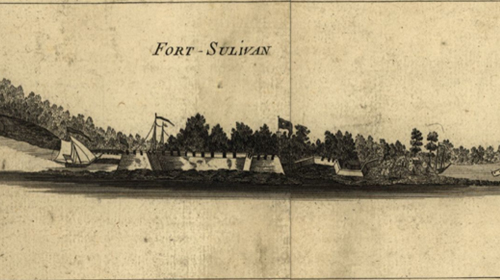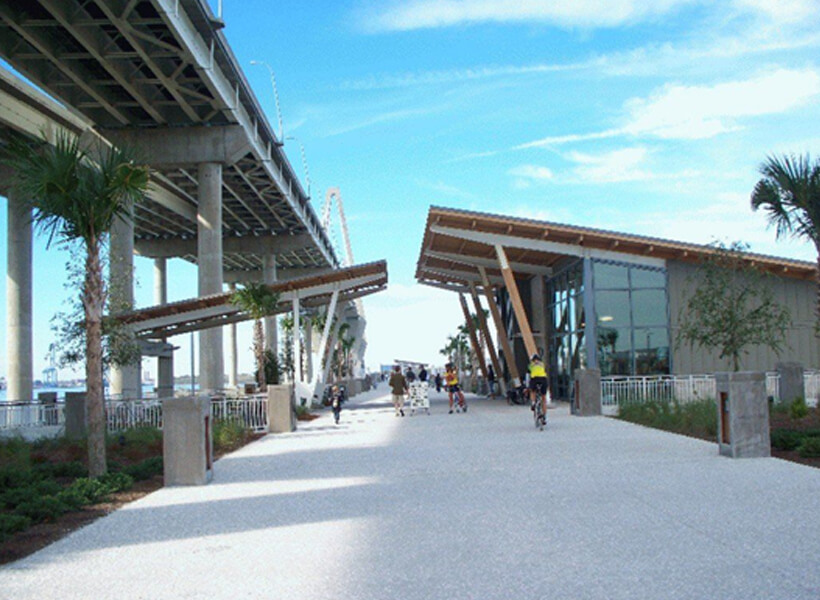By Christina Butler/Butler Preservation LC for Charleston Empire Properties
22 November 2020
Mount Pleasant and adjacent Sullivan’s Island are chock full of historic waterfront sites that double as parks, offering entertainment and education for visitors in one stop. Once part of Christ Church Parish, the waterfronts east of the Cooper River and along Charleston Harbor were important sites in the defense of Charleston and its coastal communities from the American Revolution to the Civil War, and beyond into the World War Two era. It’s especially fitting that one of these sites is now known as Patriots Point in an homage to the area’s important military history. Just down the the water’s edge are two other historic sites, Fort Moultrie on Sullivan’s Island and Mount Pleasant Memorial Waterfront Park just below the breathtaking Ravenel Bridge.
Fort Moultrie, the first fort erected on Sullivan’s Island, was an incomplete installation of palmetto logs and sand when Sir Peter Parker of the Royal Navy attacked it with nine men-of-war ships in the summer of 1776, expecting to quickly defeat the American forces manning it.

A Plan of the attack of Fort Sulivan, the key of Charlestown, in South Carolina, on the 28th. of June.
Seemingly miraculously, the namesake of the fort, Colonel William Moultrie, led it through a pitched battle in which the spongy nature of the Lincoln-Log joined palmetto logs and earthen outer covering negated the continued barrage of enemy fire. After nearly nine hours of fighting, the British ships were forced to give up the fight as the tide changed and they began to become beached. This small but noble fort became the site of the first patriot victory in South Carolina against the British. The date, 28 June is known as Carolina Day and still celebrated each year in the Palmetto State. The state flag even bears a palmetto and crescent moon in honor of the victory at Fort Moultrie.

A plan of the attack of Fort Sulivan, showing an aerial view of the incomplete palmetto log fort.

Plan d'Amboy. Vues de la rade de Charles-Town et de Fort Sulivan, mai 1780.
The fort was mostly abandoned and eroded by 1807, when it was expanded and rebuilt with brick barracks and gun emplacements as part of the new coastal defenses built in the Federal era. Moultrie became a Confederate installation in 1860 and was luckier than nearby Fort Sumter because it was just out of range of the Union guns that hammered away from Morris Island into the harbor and the City of Charleston. The fort remained an active installation into the World War One era.

Soldiers on duty at Fort Moultrie circa 1900. Library of Congress.
During World War Two, Charleston’s coastal defenses reactivated and updated once more. Fort Moultrie, which had 3,000 personnel stationed on site in the 1940s, was expanded and modernized with new bunkers, weapons emplacements, and observation stations. These updates are still in place and make Fort Moultrie a true timeline of military history in the Lowcountry. Fort Moultrie is now a National Park Service site and includes a museum with military artifacts and dioramas of the earlier iterations of Moultrie. The historic early nineteenth century iteration of the fort sits on Sullivan’s Island beach and is completely open to the public. World War Two enthusiasts might also want to drive down the road to Sullivan’s Island Poe Branch of Charleston County Library, which is housed in a bunker constructed during the same installation updates as Moultrie.

A National Park Service photograph showing the federal era buildings in the foreground and WWII additions (in black) in the background.
Patriot’s Point, the Charleston Harbor Marina, and Mount Pleasant Memorial Waterfront park are all located on a landmass that was historically called Hog Island, which was the site of the first naval battle of the Revolutionary War in South Carolina in 1775. Patriot forces sunk old ships in the Hog Island Channel hoping to block enemy access to the Wando and Cooper Rivers, when they were fired upon by the British in one of the first southern hostilities of the looming Revolution. The Confederate forces also tried to defend the channel nearly 100 years later during the American Civil War by placing mines in the channel

Hog Island and Mount Pleasant in 1918. USGS Topographic Survey.
In 1975, part of Hog Island was transformed into the all-inclusive Patriots Point museum, with the USS Yorktown CV-10 as the star of the show. The Essex-class aircraft carrier was built in Newport News, Virginia in 1941 and was named in honor of Yorktown CV-5 which was lost during the Battle of Midway in 1942. The Yorktown CV 10 entered service in 1943 and was involved in several Pacific campaigns, earning eleven battle stars. It is one of few carriers to survive both the war and the scrapyard, making it an important ship and a perfect museum. Yorktown was relocated to Charleston in 1975 and became a National Historic Landmark in 1986.

F6F-3 Hellcats aboard USS Yorktown (CV-10), 31 August 1943. US Navy Department.
Visitors to Patriots Point can tour most of the Yorktown, including her decks where various historic military planes and jets (corsairs, hellcats, cobras, tomcats, and more) are on display. Inside the ship is a military museum and temporary home of the Congressional Medal of Honor Museum.

The Yorktown. Courtesy of Patriotspoint.org
Guests can order lunch in the mess hall and eat on the antique lunch trays from the World War Two era, and there are special big band events and celebrations at Patriots Point throughout the year. Don’t miss the Fourth of July spectacular fireworks display. Admission to Patriots Point also includes the USS Laffey, the most decorated destroyer still in existence, the USS Clagamore (a WWII era submarine that was updated for sonar during the Korean War), and a Vietnam Experience exhibit.

An aerial view of the Laffey and the Yorktown at Patriots Point. Library of Congress.
Just on the other side of the Ravenel Bridge from Patriots Point, the Memorial Waterfront Park offers sports fields, pathways along the Cooper River banks, a dance and events pavilion, and a 1250-foot-long pier constructed atop the pilings from the old Silas N. Pearman bridge that was replaced by the beautiful Ravenel Bridge. The pier has swings, benches, places to fish, and a café and gift shop.

The fishing pier at Mount Pleasant Park.
Visitors enjoying the view to the south of Charleston harbor might notice a curious shipwreck in lodged in the Cooper River pluff mud; this ferro-concrete hulk is often referred to the Archibald Butt, named for a military aid to President Taft who died aboard the Titanic on its fateful voyage, but it is really the SS Col JE Sawyer.

The Old Hulk, viewed from Mount Pleasant Memorial Park.
Commissioned in 1919, it was the first concrete passenger boat in made in the United States. It sank on the Charleston side of the Cooper River in 1926. It was hauled to its current (and likely permanent) home in 1929 and is now a designated local landmark. Residents in Mount Pleasant have so many amazing historic sites on their side of the Ravenel, they barely need to venture to downtown Charleston!
Sources:
- Library of Congress map collections
- Library of Congress photograph collections
- Historic American Buildings Survey, Fort Moultrie.
- “Vessel’s Enduring History,” Post and Courier, 14 November 2010.
- Old Sunken Hull Historical Marker. Town of Mount Pleasant.http://sc-mountpleasant.civicplus.com/DocumentCenter/View/5676/Old-Sunken-Hull-Historical-Marker-2-webvers (accessed 20 November 2020.)
- Town of Mount Pleasant Historical Commission, “Old Sunken Hull,” Mount Pleasant Historical, accessed November 22, 2020, https://mountpleasanthistorical.org/items/show/42
- Christina R. Butler. “JFK and German U-Boats: Charleston During World War Two.” Kiawah Legends. Draft submitted October 2020
- Fritz Hamer. Charleston Reborn: A Southern City, Its Navy, and World War Two. Charleston: History Press, 2005.
- National Park Service. https://www.nps.gov/fosu/learn/historyculture/fort_moultrie.htm
- Nicholas Butler, “The Story of Carolina Day.” Charleston Time Machine. June 2018. https://www.ccpl.org/charleston-time-machine/story-carolina-day
- William Moultrie. Memoirs of the American Revolution, volume 2. Georgia: David Longworth, 1802.
- Patriot’s Point. https://www.patriotspoint.org/


